Protective Elements against Water-Meter Interference or
Locking
|
|
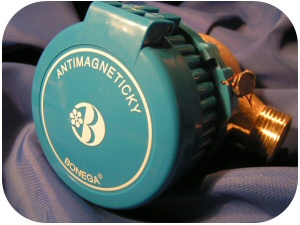
It is a sad true that there are still a lot of unfair tenants who try to
misuse the technical imperfections of some water-meters, and thus to affect
the relating measurement accuracy. In this way, they prey other users and
simultaneously, they create disputes with clearing.
Therefore, we have placed a lot of unique protective elements against
misuse onto our BONEGA® water-meters. Those elements contribute
to a more objective ratio measurement of water consumption in a household.
Only few manufacturers can be proud of so high resistance.
|
 1.
Blocking against endless rotation (subtraction to minus)
1.
Blocking against endless rotation (subtraction to minus)
Easy reading, no
subtraction.
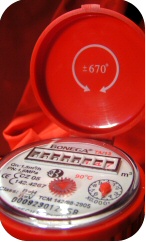
If no water flows through the water-meter, the turbine is stopped whereby it
puts up a resistance. The counter rotation “in the right direction” causes the
reverse run of the turbine, thus the aforementioned subtraction (the magnetic
couple avoids the rotation of the main shaft at the counter). Many users
succeeded in mechanizing it whereby they reach even some tens revolutions per
minute.
To keep the possibility of an easy reading, avoiding the
subtraction at the same time we have developed a gear that enables just limited
rotation (670 degrees).
The easy solution consists in the innovated securing ring combined with a lug on
the bottom brass part of the water-meter and with press-pieces on the side
cover. The transparent polycarbonate cover and the opaque side cover are bounded
undemountably.
According to the available information, the BONEGA®
water-meters are the only ones that have the aforementioned protection.

2. Unique antimagnetic resistance
The BONEGA®
water-meters withstand even a pair of the biggest permanent magnets available
on the market.
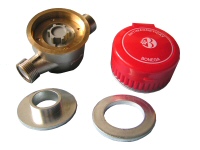 As
to the antimagnetic resistance, we supply the BONEGA® water-meters in
two designs:
As
to the antimagnetic resistance, we supply the BONEGA® water-meters in
two designs:
- Water-meters without the antimagnetic resistance (labeled as T or
S)
- Water-meters with antimagnetic resistance (labeled as TA or SA)
The difference consists in inside construction modifications that increase
the antimagnetic shielding (antimagnetic resistance) significantly. It concerns
de facto the internal antimagnetic cage, which consists of two specially
modified inter-rings with high weight and size (see Fig.)
These modifications are done since a lot of unfair tenants try to affect the
water-meters by means of magnets.
Detailed explanation
In the beginning, it has to be mentioned that thanks to higher reliability,
dry-running water-meters are used almost solely at the flats.
On these water meters, the bottom part is not connected with the counter
mechanically – by a shaft (as it is on the wet-running water-meters) but by a
magnetic coupling. No seepages or even bigger water leakages through the upper
regulating board menace (as it can be in the case of gasket wear and tear around
the shaft on the wet-running types). On the dry-running water-meters, a pair or
a tetrad of permanent magnets placed in the shaft usually ensures the motion
transmission from the shaft to the counter. Opposite in the bottom part of the
main shaft, there is usually another pair or tetrad of permanent magnets. As
soon as the turbine starts to rotate, its magnets – under influence of magnetic
forces – begin to “tear down” the magnets on the main shaft whereby the rotating
motion of the shaft is transmitted onto the counter.
The most often misuse consists in application of permanent or other outside
source of magnetism. After having been applied to the water-meter, it disturbs
the magnetic field. In that case, the saccade or even the fully stop of the
counter occur although the turbine still rotates.
Prevention
The manufacturers struggle to avoid the aforementioned phenomenon by means of
various antimagnetic modifications. They show usually themselves on the higher
bottom body, the protective cage inside a water-meter, thus they result in a no
small increase in water-meter weight. For example, the weight difference between
a ½” normal and antimagnetic BONEGA® water-meter amounts to 15 g.
Range of the problem
It is an all-European problem that is proven by the European Union
interest lasting several months. The European Union prepares the relating
standard (EN 14 154-3) in which the required minimum resistance is mentioned at
the rate 10 kA/m. There has not been stated any exact methodology yet, how this
parameter can be measured exactly.
Methodology of the antimagnetic resistance measurement
How can you find out that the water-meters have the above protective
ability? How can you measure that resistance? Which are the differences in this
resistance between the individual water-meter manufacturers?
We put these questions to ourselves some years ago. Because the
aforementioned standard is in the draft stage but the customers need to know the
exact resistance, we have chosen the above solution.
The original used methodology was based on applying the permanent magnets to
the water-meter. It was very difficult to define the parameters of such a
magnet. Only a very inexact dimensional comparison was often used.
In 2003, we placed an order with the Slovakian Technical University in
Bratislava to develop an as exact as possible measurement methodology based on
the stepless control of magnetic flow which shall determine the value in kA/m
exactly when a water-meter begins to measure (saccade of the counter), and the
value when the measurement is fully stopped.
Our basic preconditions:
1. To create a methodology for stepless measurement of the water-meter
antimagnetic resistance which have to:
- define the repeatable processes clearly
- detect the influence of magnetism in tree various directions (horizontal,
vertical and at a 45° angle)
- end with an output which has to include a concrete resistance value in
kA/m which will define the condition when the inexact measurement begins (thus
the saccade of the counter) and when the measurement is fully interrupted
(counter stop)
- measure the antimagnetic resistance under the conditions similar to usual
application, i.e. with the water flow-rate of the critical value which is 5
l/min (0,2 x Qn = 0,2 x 1,5 m3/h = 5 l/min.) and in the horizontal position of
the water-meter
- do the measurement both within the magnetic field of ferrite permanent
magnets and within the magnetic field in the air gap of the single-way
electromagnet
2. To choose three best water-meters for the selection, based on our 12
submitted constructional varieties of antimagnetic modifications for the BONEGA®
water-meters
3. To do the comparison with a water-meter without antimagnetic modification,
with a zero primary variety of an antimagnetic modification and with three
varieties of the selection.
4. This measurement has to result in a recommendation for the best antimagnetic
modification suitable for mass production.
After corresponding constructional modifications and tests, we have
fulfilled our objective: to offer a household water-meter which is as
resistant as possible in its magnetic properties and which has to withstand at
least a pair of the biggest ferrite permanent magnets available on the market.
The BONEGA® water-meters exceed
the requirements
of the European standard by up to 1300 %.
- the testing was finished in the first half 2004 (the methodology and
protocol are free for view) .
- the antimagnetic resistance modifications were done to withstand the
influence of the heaviest permanent magnet known to us (even it is hardly
available for private persons), which has the value 44 kA/m as a separate one
and 72 kA/m in a pair.
- coincidentally, the performed methodology takes into account the same
distance from the water-meter body (20 m) for one condition, as does the draft
of the aforementioned all-European standard, so it possible to compare even
today.
- the research of various varieties has resulted in an extraordinary high
protection against magnetizing from outside, provided by the household
water-meters BONEGA® . The BONEGA® water-meters exceed
the requirements of the European standard by up to 1300% whereby they are ones
of the magnetically most resistant water-meters in Europe.
Influence on price
Úprava má jen zanedbatelný dopad na zvýšení
ceny.
Nowadays, we have appeared on the imaginary top of water-meters with the
highest antimagnetic resistance.
The modification has only an insignificant affect on the increase in price. An
additional and very expensive modification by the outside magnetic cage is not
necessary more.
Difference between the BONEGA® water-meters with the antimagnetic resistance
and without it
| Comparison of parameters: |
| Type of BONEGA® water-meter |
Distance of the action of magnet from the water-meter |
Value in the standard draft EN 14154-3:2005+A1 |
Resistance of the BONEGA® household water-meters |
We exceed the values in proposed standard EN 14154-3:2005+A1 by
%
|
We exceed the values in proposed standard EN 14154-3:2005+A1 in
multiples |
| Normal version (S/T) |
20 mm |
10 kA/m |
Up to 16 kA/m* |
Up to 160 % |
Up to 1,6 times |
| Antimagnetic version (SA/TA) |
20 mm |
10 kA/m |
94-130 kA/m* |
940 - 1300 % |
9,4 times to 13 times |
|
*according to the water-meter
position
|
Conclusion:
- the antimagnetic resistance is an all-European problem
- as compared to the old methodology and the European standard draft, our
method is much
more accurate and balanced. It enables to determine exactly when the
water-meter begins to lose through its inaccurate measurement and when its
stops.
- thanks to it, the modifications executed on the BONEGA®
water-meters are extraordinary effective, they withstand even a pair of the
biggest permanent magnets available on the European market (44 kA/m as a
separate one and up to 72 kA/m in a pair)
- antimagnetic resistance of the BONEGA® water-meters is on the
worldwide top
- even the normal BONEGA® water-meter (without antimagnetic
modifications) hast its antimagnetic resistance higher than is that prescribed
by the European standard draft (it has up to 16 kA/m)
- the installation of the antimagnetic water-meter is cheaper than possible
additional outside modifications.
The Declarations on antimagnetic resistance are available for download
under Certificates and declarations.
The Protocol on measurement is also
available on a
separate page because of its volume.

3. Protective opaque side plastic cover
Are you sure that nobody
digs into your water-meters?
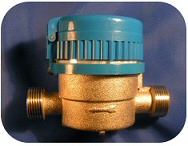
The other possibility how to put a water-meter out of operation is to bore
the dial cover on the side and to put an object through it, which locks the
counter run. To choose the right place you have to see in –it is enabled by a
transparent cover on other water-meters. This mechanical intervention is
irreversible but unfortunately mostly little visible.
The BONEGA® household water-meters have a side cover which is
opaque and irremovably connected with the transparent cover of the device. It
protects the counter device in mechanical and optical way.

4. Input screw joint sealing
Are you sure that your
water-meters
cannot be rotated by 180° ?
Due to an unsuitable sealing, some water-meters can be dismantled or rotated
by 180° without following recognition. The plastic pins can be “desealed” and
again “sealed” with certain temperature, the copper wires can be drag out and
string with a little practice.
Therefore, the return to traditional sealing with copper strands is recommended
in the last time. The strand is to be drawn through the hole in the screw joint
nut and through the sealing hole on the water-meter body. The ends are drawn
through a lead sealing which closes and secures the strand ends against dragging
out. After that, the registered mark is embossed into the sealing. To do this,
the water-meter has to be adapted correspondingly.
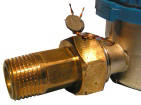
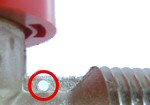

Water-meters BONEGA®
- They enable to seal the input screw joint during the installation directly
onto the formed lug with a hole on the water-meter body (the photo in the
middle). It is possible to use a screw joint cap nut with “a hole” (the photo
on the left) or with “an eye” (the photo on the right).
- in contrast to the only “winding” the strand round the body, this is a
design of higher quality, which cannot be misused
- this solution makes the installation cheaper significantly (a short strand
with sealing is enough)
- they enable to seal the inlet screw joint by a quality plastic divided
ring with a pin seal (here is suitable only the screw joint without “eyes”)
- they avoid temporary dismantling or rotation of the water-meter by 180°
and thereby the reverse run

5. Counter sealing
The upper and bottom
parts cannot be separated,
so the counting cannot be interrupted.
 The
water-meter is protected with a security ring with a seal avoiding the
separation of the counter from the bottom part and therefore it is not possible
to interrupt the continuous counting of water consumption, as it is possible
with some water meters.
The
water-meter is protected with a security ring with a seal avoiding the
separation of the counter from the bottom part and therefore it is not possible
to interrupt the continuous counting of water consumption, as it is possible
with some water meters.
- The suitably technically solved ring secures a very closed and exact
interconnection of the bottom body with the counter
- The ring also enables an easy sealing by a copper strand directly through
a joint (lock) of the ring or just by sticking a sealing mark over it (the
less secure way)
- Even after being sealed, the securing ring can be rotated freely (it still
enables a comfortable detection of the condition)



 As
to the antimagnetic resistance, we supply the BONEGA® water-meters in
two designs:
As
to the antimagnetic resistance, we supply the BONEGA® water-meters in
two designs:




 The
water-meter is protected with a security ring with a seal avoiding the
separation of the counter from the bottom part and therefore it is not possible
to interrupt the continuous counting of water consumption, as it is possible
with some water meters.
The
water-meter is protected with a security ring with a seal avoiding the
separation of the counter from the bottom part and therefore it is not possible
to interrupt the continuous counting of water consumption, as it is possible
with some water meters.